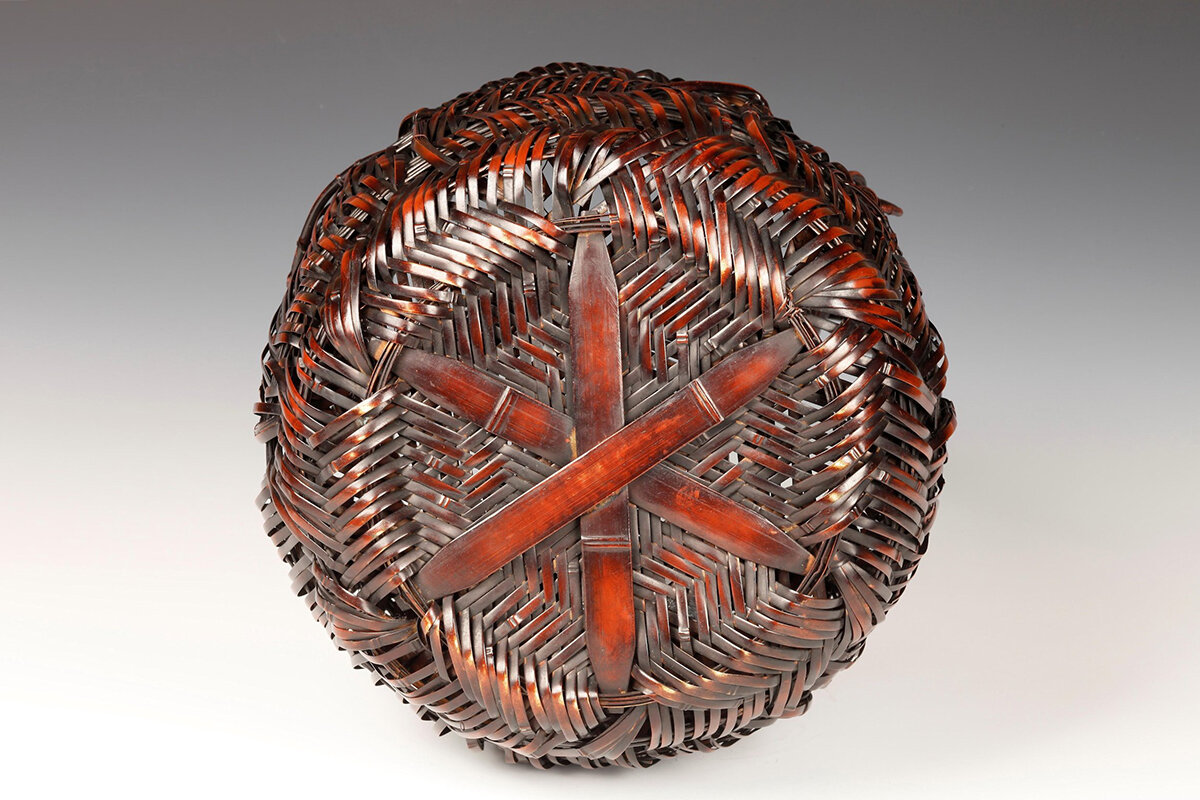MEIJI-TAISHO
MORITA CHIKUAMI & KUROI KOMIN, RED BRONZE FLOWER BASKET
Hana-kago or flower arranging basket in a globe form with a loop-style handle, woven of red bronze. Designed by Morita Chikuami and the bronze made by Kuroi Komin. Late Taisho – early Showa era, circa 1924 – 1930.
With the tomobako or original box, inscribed on the exterior of the lid: Do-sei Yama-michi Kago or Basket Made of Bronze (titled) Mountain Road; and on the reverse of the lid signed: Morita Shintaro Saku or Designed by Morita Shintaro, and sealed; and also signed: Kuroi Komin Sei or Made by Kuroi Komin, and sealed: Komin.
Morita Chikuami (the go or art name of Morita Shintaro) was a Kyoto bamboo artist who was active from the late Meiji era into the early Showa era. His work won a prize at the 5th Naikoku Kangyo Hakurankai (the 5th Domestic Industrial Exposition) in Meiji 36 or 1903.
For another example of his work, c.f. Kagedo’s catalogue Shadowed Reflections, Japanese Views, number 186.
A Kyoto metal artist who worked in primarily in iron, Kuroi Komin is first recorded as winning a prize in 1924, at the Dai Ikkai Kyoto Bijutsu Kogei-kai Ten (1st Annual Exhibition of the Kyoto Fine Art Craft Association). Upon its formation in 1928, he became a member of the Kingei-kai (Metal Craft Association). In 1930, Komin entered an iron and gold stationery box into the Dai Ikkai Kyoto Kogei Bijutsu Ten (The 1st Annual Kyoto Craft Art Exhibition) and won the tokusho or grand prize. His first acceptance into the national exhibitions came with the 13th Teiten in 1932, followed by the 14th and 15th Teiten in the next two years. In 1936, he showed at both the Kaiso Dai Ikkai Teiten and the Bunten Kansaten. In 1937, he entered a sculptural piece into the Dai Ni-kai Shi Ten (The 2nd Annual [Kyoto] City Exhibition) and won a prize. He participated in the Hoshukuten in 1940 and in the 4th and 5th Shin-Bunten held in 1941 – 1942.
For other pieces by Komin, c.f. Kagedo’s catalogue Breaking Light, numbers 122 & 123 ; as well as Kagedo’s catalogue Awaiting the Moon, number 140, and Blue Wind, number 23.
This collaboration between a bamboo and a metal artist may be the only example of its kind, and probably represents a work made for exhibition. Both were Kyoto artists, so it may have been shown at one of the municipal art exhibitions that were held in the late 1920s.
Though metal baskets were made from the end of the 19th into the 20th century, in both silver and bronze, these appear generally to have been made for the foreign export market. They generally never rise to a level beyond the decorative and when handled typically reveal mediocre workmanship. Unlike those curiosities, this masterpiece of trompe l’oeil work stands as a wonder of both basketry and of metalwork. Chikuami’s design, proportions, and plaiting complexity all stand with the best studio basketry of the age. The remarkable ability shown by Komin to perfectly echo the coloration and appearance of antique, smoked bamboo with its surface variations and node texture seem equally stunning.
Morita Chikuami & Kuroi Komin, Red Bronze Flower Basket
Artist Name: Morita Chikuami, Kuroi Kumin
Period: Taisho Showa
Mediums: Bamboo, Metalwork
Form: Basket
Origin Country: Japan
16 ½” high x 11 3/8” wide x 11 1/8” deep
This piece is no longer available.


